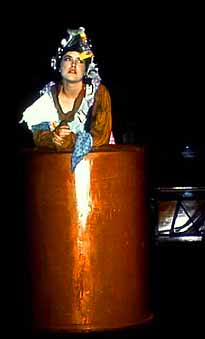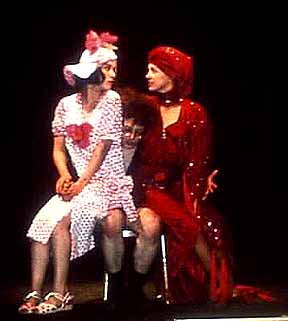St. Petersburg municipal music folk theatre LAD was organized in November of 1992. LAD works in the style of enviromental happening, in which our spectators are participants of the show - they dance, sing and even play Russian folk instruments with us.
The theatre is focusing its production on musical and dramatic material linked with Russian history, with special attention given to folk culture.
The traditions of "sit-down gatherings" are some of the most interesting and unique in Russian popular customs. On the fourteenth of October, everywhere in Russia, orthodox Christians celebrated "Pokrov" Day, the day when the earth was topped with snow for the first time. Up to that time, autumnal agricultural work has to be completed, and the glax must be threshed, pressed down, and prepared for spinning. After this celebration, during the long winter evenings, distaff will begin to tap and a thin thread will slip under the girls' fingers... For four full months, girls will meet for a "sit-down gatherings".
Usually, a "sit-down gatherings" was geld in the gouses of girls by turns, or in a peasant gouse that was specially "farmed" - taken on lease from lonely old prople of a poor widow and paid for with housework or food. The house was then cleaned up, with all unnecessary things left along the walls, and a cross-bench was placed to fence off a space to dance and play. Until the fellows arrived, there was dusk in the peasant house, in order to save fuel for lighting. So as to not fall into drowsiness, and to put themselves in the mood for the evening, the girls begin to sing.
And then a calling song is heard, a door is opened, and dashing fellows appear, singing "chastooshki" (two - or four-line verses, usually humorous and topical, sung in a lively manner). Then a gaily colored round dance begins,
and there is dancing, singing, and cheerfully crude plays.
This is the folk material of Northwestern Slavs, "Krivichi" from Pskov and "Sloveni" for Novgorod (ancient towns of Russia), and it is used in our performances.
The Artistic Director of LAD-Theatre is Boris Vorontsov.
For more information call 532-6476, or 545-0809, or 254-5139
Dances - G. Novikova, Songs - T. Haminova
ST. PETERSBURG - "Trees are green," says Gennady Abramov, "but sometimes in the morning they are rose-colored. It all depends on how we see them."
Sitting upright in a hard-backed chair in his hotel room across Nevsky Prospekt from the Moskovsky train station, Abramov is talking about the many different approaches to contemporary dance in Russia. He has a way of peppering his conversation with metaphors and philosophical asides, pointing out that the basic laws of dance hearken back to such philosophical notions as the principle of opposites and the principle of continuity. "It is no coincidence that contemporary dance arose at the same time as existentialism," he adds. "It is an art form directed toward facilitating self-expression."
Looking at least 10 years younger than his age of 65, Abramov, Russia's preeminent guru of physical theater, has earned the right to philosophize and talk about dance. He was recently in St. Petersburg to take part in the Golden Mask festival as a jury member in the field of musical theater, but his own work as the founder of the renowned Class of Expressive Plastic Movement and, since September, as the artistic director of the Department of Contemporary Dance at the Humanitarian University in Yekaterinburg, was not far from his mind.
No one with even a passing interest in Moscow theater in the 1990s missed Abramov's Class of Expressive Plastic Movement, one of the most innovative and influential non-verbal companies of its time. Attending its strange shows with such titles as "The Barrier of Isolation," "They Come and They Go," "The Herd" and "The Bed" - a Golden Mask winner as best contemporary dance production in 2000 -- was something of a ritual for serious theater-goers. There was magic in Abramov's young men and women defying gravity and the limitations of physiology as they nimbly crawled up walls, across ceilings and all over each other. It hardly mattered that you often had no idea what was going on - it was beautiful, it was liberating, it was often very funny and it was always exciting to see actors working at such a high level of physical agility.
"The magic of the Class was that I was invisible," Abramov comments. "The actors were the sole authors of the shows, although I had done everything to make that possible."
The Class of Expressive Plastic Movement was a logical step in Abramov's development as an artist. As a classical dancer working in the provinces from 1960 to 1972, he performed most of the world's leading male ballet parts. In cinema, he choreographed movement for such luminaries as the Oscar-winners Vladimir Menshov and Nikita Mikhalkov. In theater during the 1980s, he staged movement for several of Anatoly Vasilyev's legendary productions. When Vasilyev established the School of Dramatic Art in the late 1980s, he asked Abramov to teach movement and dance.
Little did anyone know that the first class of students that Abramov assembled in November 1990 would evolve into the Class of Expressive Plastic Movement. "It was a coincidence," Abramov says, "we never set the goal of creating shows; they always arose from the process of our studies."
The point was to supply Vasilyev with actors who could do more than just speak well on stage but the group soon evolved into an independent organism within the theater. As Abramov gained international recognition, however, his success increasingly caused discomfort for Vasilyev who eventually cut off support. With no home base and next to no funding, the Class of Expressive Movement toured European festivals to acclaim while Abramov frequently was invited to conduct master classes. The clearest stamp of approval for what he had achieved occurred when the German contemporary dance choreographer Sascha Waltz asked several of his actors to participate in a major international project she called "Na Zemle" (On the Earth).
"By 1999 I could say I had brought my actors to the attention of Europe," Abramov notes. "When casting 'Na Zemlye,' Sascha Waltz chose my actors to fill six of the 12 slots."
In retrospect, that accomplishment might be seen as the beginning of the end. In January 2001, Abramov organized a contemporary dance festival called Movement Ahead which was intended to celebrate the 10th anniversary of his Class of Expressive Plastic Movement and set the tone for the future. Instead, it was the company's swan song. Although on rare occasion former members of the Class still perform "The Bed," a piece in which three actors interact with each other and a constantly transforming brass bed, Abramov now declares the Class "closed."
"Keeping a troupe was never the idea," he explains. "In 10 years we exhausted our potential."
If that is true of the Class, it certainly is not of Abramov or of his former students, many of whom have gone on to significant careers as performers and choreographers. Vladimir Belyaikin, an original member of the Class, frequently works with Yury Lyubimov at the Taganka Theater while Albert Albert, one of the key performers in "The Herd," has staged movement for numerous dramatic theaters. Albert's own production of "The Leaves of Bodies" for a group called P.O.V.S.Tantsy (a pun placing the word "dance" inside a word meaning* "rebels") was nominated for a Golden Mask award in the contemporary dance category this year.
Abramov, meanwhile, appears ready to go back to the future in his work at the Humanitarian University in Yekaterinburg. He again has turned to teaching, taking over a vast program that offers training in contemporary, classical, jazz, improvisational and folk dance, as well as in directing and teaching.
"I love teaching because every student is a new teacher," he says. "It never matters how many mistakes they make because mistakes in art are what eventually become innovation. The key to teaching is not to teach. In the ten years that the Class existed, I don't know who learned more - my students or me."
Asked if he foresees the formation of something similar to the Class of Expressive Plastic Movement, he is careful to avoid clear statements of intent. But, he suggests, "If I am going to continue developing, I must educate new people who think like I do. We must educate literate performers, ones who know that the new grows out of what has been discovered before us."
Abramov explains that one of his goals as a teacher is to instill in his students an understanding that everything is connected, that "each movement is motivated by the previous one just as it, in its turn, motivates the next one. We must tell kids that music arises from seven notes; painting from seven colors; and dance from seven movements, but that we can be free within these seven movements only if we recognize that they do not exist in isolation," he said.
Abramov continues to live in Moscow while traveling to Yekaterinburg twice a semester to conduct three-week master classes and oversee the examination process. To do this, and to continue work on an encyclopedia he is writing about movement, physical theater and modern dance, he now turns down offers to work abroad.
"I consider it important to apply all my energies to Russia now," he states. "I want people coming here to study with me as they did when I had my Class of Expressive Plastic Movement."




 Liberty is always unfinished business. --anonymous
Liberty is always unfinished business. --anonymous







